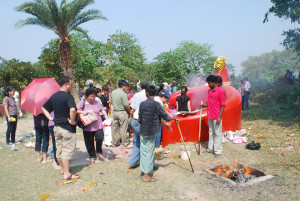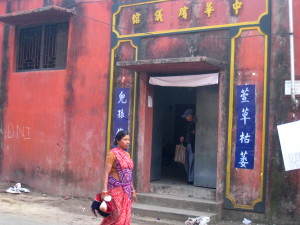By DOUGLAS PIZA, 4/05/2016. This title is perhaps more a provocation than an accurate statement. It is probably truer to say that Kolkata has only one Chinatown in the central area – and it is dwarfing. Yet Kolkata does have three distinct areas that keep a close relation with the Chinese migrants and Chinese Indians of the city: Chinatown, Tangra, and Achipur. Today’s post is about these spaces, and how they fit into the broader history of the Chinese diaspora in India. I base my account largely on a work by Zhang Xing and Tansen Sen[1].
Let’s begin with Achipur, since its history goes back to the first Chinese colony in India. Achipur is the name of the land given in the 1778 to the Chinese tea trader Yang Dazhao, nicknamed Atchew, by the British Governor-General of India Warren Hasting. Well connected with the British rulers, Atchew decided to use the land to produce sugar, and inaugurated a mill that would soon recruit Chinese workers brought by Atchew. While there were Chinese people living in Kolkata (then Calcutta) and other cities, especially after the increase of trade routes between Guangzhou (then Canton) and European cities via India, Achipur is the first instance of commissioned Chinese labor force migration that settled in a colony. Achipur, which is located roughly 20 miles from Kolkata, became nowadays a main pilgrimage destination of the Chinese diaspora in India, especially during the Lunar New Year. Reconstructed in 2004, the horseshoe-shaped tomb of Atchew still stands in Achipur, so does the Bogong-Bopo temple which is one of the oldest Chinese temples in India. The memory of Achipur acquired a religious connotation as this mythic pioneer figure is now perceived as a collective ancestor.

The Chinese living in Kolkata formed over time what one can call a Chinatown in the Bowbazar area in central Kolkata. Cantonese, Hakka, and a smaller number of Fujianese people residing in Kolkata in the second half of the 18th century soon built temples and other sort of associational spaces. Other cities also testified to the emergence of Chinese communities nuclei, such as in Mumbai. In the 19th and first half of the 20th century, these communities grew in number and become more and more noticeable. Also, Chinese from different region of origin started migrating to Southeast Asia, as people from the Shangdong and Hubei provinces in the first half of the 20th century. Curiously, distinct Chinese groups based on region of origin in China specialized in different economic activities: Cantonese were commonly carpenters, Hakkas shoemakers and tannery workers, Hubeinese dentists, and Shangdong people were silk traders.
Yet another space in Kolkata concentrated many Chinese migrants and maintains part of this legacy, namely Tangra. Given that the Hindu caste system proscribes works with leather to all but the untouchables, Hakkas specialized in two occupational niches: shoemaking in central Kolkata and later also tanning in the Tangra region. Both areas in Kolkata testified to the growing of the Chinese community in numbers, ethnic associations, religious temples, Chinese schools etc.

Of all three spaces, perhaps only central Kolkata’s Chinatown still remain an area of concentration for the Chinese diaspora living in the city.
[1] Xing, Zhang and Tansen Sen. 2012. “The Chinese in South Asia.” Pp. 205-26 in Handbook of the Chinese Diaspora, edited by Tan Chee-Beng. London and New York: Routledge.
